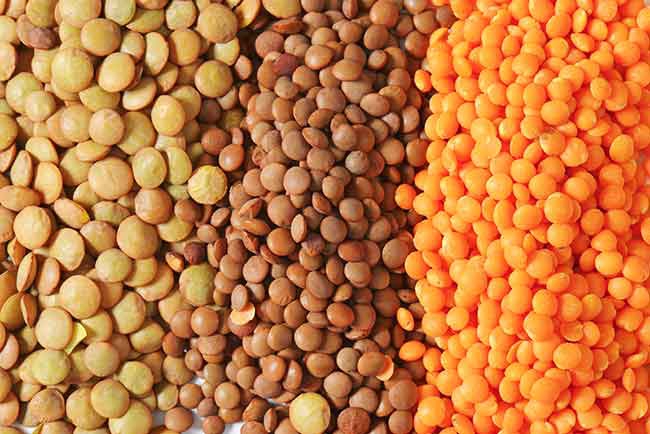
Pulse research
March 21, 2016
By Dr. John Michaelides
There are many underdeveloped opportunities for baking with pulses being researched today.
 The legume family of crops makes up a large part of farming in Canada. Pulses are definitely a local product! Photo: Fotolia
The legume family of crops makes up a large part of farming in Canada. Pulses are definitely a local product! Photo: FotoliaPulses are edible seeds of crops in the legume family. Beans, peas, lentils, and chickpeas are some of the best known. Pulses typically grow in pods. Some crops produce seeds in a pod that are not technically pulses and contain a substantial amount of oil. The oil can be commercially extracted and these are categorized as oilseeds.
Some examples are soybean and rapeseed or canola. The legume family represents a vast number of species that are found all around the world. Within the groups of beans, peas, lentils and chickpeas, many varieties are grown as food. Bean varieties include black, navy, cranberry, pinto, dark red kidney, light red kidney, as well as many others. Many common names of these pulses can be found within the different geographical regions of the world.
The legume family of crops represents a substantial portion of farming efforts in Canada. The majority of these crops are dried or processed whole.
Many researchers have investigated the nutritional aspects of pulses over the years. They are known to contain a wealth of nutrients for the human diet. They have substantial amounts of good quality protein and complex carbohydrates including soluble and insoluble fibre. They are low in fat. They are a good source of vitamins and minerals, such as B-complex vitamins, calcium, potassium, iron, phosphorus and zinc. Pulses offer a plethora of other health benefits beyond regular nutrition. They contain various antioxidants that may reduce the risk of certain diseases and promote overall human health. Numerous research investigations have identified a number of phytochemicals in pulses that can act as antioxidants or have other positive effects in preventing the onset of chronic diseases such as cancer, heart disease and diabetes, among others. Beans contain a chemical compound that can block the enzyme (amylases) in the body that breaks down starch. The partially undigested starch ends up directly in the colon, where it is fermented and acts as a prebiotic. In addition, it reduces the absorption of calories from starch. Pulses have a low glycemic index (GI) value, making them an ideal food for those with a risk of diabetes. For example compared to white bread with a GI value of 100, the approximate GI values for chickpeas are 40, 42 for lentils, 45 for split peas, and beans can vary from 40 to 55. Legumes are also known to promote satiety. There is great potential in this area for weight control and reduction of the risk of other chronic diseases that are associated with being overweight.
The use of pulses as ingredients in North America and Europe is underdeveloped. Pulses in general tend to be consumed whole. A limited supply of ingredients derived from these pulses is used in food products. The potential for the development of healthy ingredients, especially for weight control, lower GI, and prebiotic markets, is great. Bean, pea and other flours are available and finding their way into gluten-free and other food products. Some dietary fibre ingredients from pulses have also been developed and marketed. The opportunity for greater utilization of soluble and insoluble dietary fibre is big.
Protein and starch ingredients with specific functional properties have been developed. Several manufacturers and suppliers of ingredients from pulses are known in Canada and the U.S. Pea fibre and pea flour are commercially available in Canada. Pea hull fibre (approved by Health Canada) has been available for many years and is being used in many food products. Pea flour is produced by grinding green or yellow peas and is used in bakery products. Pea protein is also available. Pea protein is an excellent emulsifier and thus improves texture and ensures better cooking results. It is a concentrated source of protein with a well-balanced amino-acid profile, and is easily digestible due to the elimination of anti-nutritional factors during the manufacturing process. It has a neutral taste and it can be easily incorporated into many types of food products.
Much research is being carried out involving better processing techniques for pulses, and the development of specialty ingredients such as flour mixtures that will reduce the fat absorption of fried foods. There is also work being done on the de-flavouring of bean flours, as well as fractionation and separation of starches and proteins. Extruded snacks represent a very good opportunity to use these flours. Flours from pre-cooked and raw navy, pinto, black, cranberry, light red, dark red, romano, and great northern beans are also being explored. These flours could be used to improve the nutritional value of products such as muffins, tortillas, and gluten-free breading and batters. They could also be used as a thickening agent for soups, sauces and other food products. Pea flours tend to have a stronger flavour, so product formulations would need to be adjusted accordingly.
One of the most recent advances in the application of pulses is in the development of gluten-free food products, and especially baked goods. For the gluten-free baked goods industry, alternatives to wheat flour are difficult to find. Rice flour is extensively being used but pulse flour is becoming popular and its application is becoming more extensive. Research on the technology of application of certain enzymes to pulse flour in order to improve its performance in gluten-free baked goods has been carried out. In particular, the enzyme transglutaminase has the ability to link certain amino acids within a protein matrix or from different proteins, thus forming complexes that can perhaps mimic the action of gluten in baking systems. This enzyme can link together the amino acids glutamine and lysine, both of which are present in pulses.
Ingredients from pulses represent a great opportunity for the baking industry. They are nutrient dense and have no known allergenic properties. The importance of these crops in the human diet has been recognized this year by the United Nations, which has declared 2016 the International Year of Pulses.
Print this page

Leave a Reply